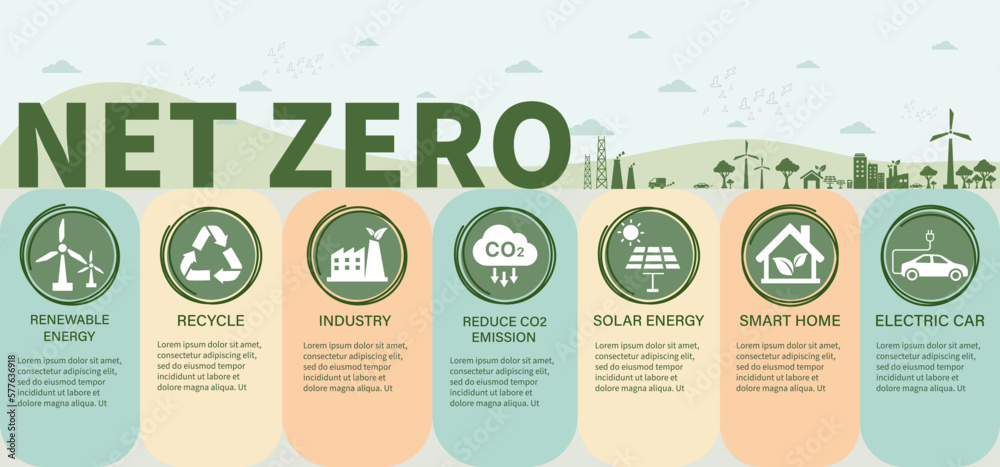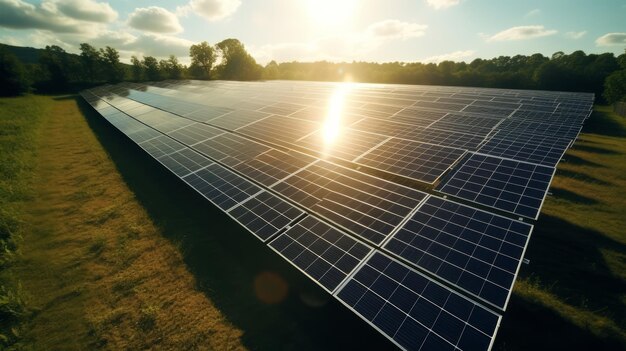
The Concept of Net-Zero Emissions Explained: Your Comprehensive Guide to a Sustainable Future
In today’s global conversation about climate change, few terms are as vital and frequently discussed as "net-zero emissions." It’s a concept that holds the key to tackling our planet’s most pressing environmental challenge, but for many, it remains a bit of a mystery. What does it truly mean? Why is it so important? And how can we possibly achieve it?
This comprehensive guide will break down the concept of net-zero emissions into easy-to-understand language, helping beginners grasp its significance and the monumental effort required to reach this crucial goal.
Understanding the Basics: What Exactly Are Emissions?
Before we dive into "net-zero," let’s clarify what "emissions" are.
Simply put, emissions refer to the release of gases into the atmosphere. When we talk about climate change, we’re specifically concerned with Greenhouse Gas (GHG) emissions. These gases trap heat in the Earth’s atmosphere, leading to a phenomenon known as the greenhouse effect. While a natural greenhouse effect is essential for life on Earth, human activities have dramatically increased the concentration of these gases, causing the planet to warm at an unprecedented rate. This is what we call global warming or climate change.
The main greenhouse gases responsible for this warming include:
- Carbon Dioxide (CO2): The most common GHG, primarily released from burning fossil fuels (coal, oil, natural gas) for energy, transportation, and industry.
- Methane (CH4): A potent GHG released from agriculture (livestock, rice cultivation), landfills, and fossil fuel production.
- Nitrous Oxide (N2O): Emitted from agricultural practices, industrial processes, and the combustion of fossil fuels.
- Fluorinated Gases (F-gases): Synthetic gases used in refrigerants and industrial processes, incredibly powerful in trapping heat.
Every time you drive a car, turn on a light powered by fossil fuels, or even eat certain foods, you’re contributing to these emissions.
So, What is "Net-Zero Emissions"?
Now that we understand emissions, let’s tackle "net-zero." The term "net-zero" doesn’t mean stopping all emissions entirely. That would be incredibly difficult, if not impossible, given our current reliance on energy and industrial processes.
Instead, net-zero emissions means achieving a balance between the amount of greenhouse gases put into the atmosphere and the amount removed from it.
Think of it like a bathtub:
- Water flowing in: These are the greenhouse gases we emit through human activities.
- Water draining out: These are the greenhouse gases we remove from the atmosphere.
To reach net-zero, we need to ensure that the water flowing in is equal to the water draining out. In other words, for every bit of greenhouse gas we release, an equivalent amount must be taken out.
Key components of net-zero:
- Drastic Reduction: The primary focus is on cutting down emissions as much as possible in the first place. This means transitioning away from fossil fuels, improving energy efficiency, and changing industrial and agricultural practices.
- Residual Emissions: Even with the best efforts, some emissions will likely remain from sectors that are very hard to decarbonize (e.g., certain industrial processes, aviation). These are called "residual emissions."
- Carbon Removal: To offset these residual emissions, we need ways to actively remove CO2 (and other GHGs) from the atmosphere. This can be done naturally (like planting trees) or through technological solutions.
Net-zero is often used interchangeably with "carbon neutrality," though "net-zero" is generally considered broader, encompassing all greenhouse gases, not just carbon dioxide.
Why is Net-Zero So Crucial? The Urgency of Climate Action
The concept of net-zero isn’t just an environmental buzzword; it’s a scientific necessity to avert the most catastrophic impacts of climate change. Here’s why it’s so critical:
- Limiting Global Warming to 1.5°C: The Paris Agreement, a landmark international accord, aims to limit global warming to "well below 2°C above pre-industrial levels and pursuing efforts to limit the temperature increase to 1.5°C." The Intergovernmental Panel on Climate Change (IPCC), the leading international body for assessing climate change, has made it clear that achieving net-zero emissions globally by mid-century (around 2050) is essential to have any hope of staying within the 1.5°C target. Exceeding this threshold significantly increases the risks of severe heatwaves, droughts, floods, and sea-level rise.
- Avoiding Tipping Points: Beyond certain warming levels, Earth’s natural systems could reach "tipping points," leading to irreversible changes like the collapse of major ice sheets or the dieback of rainforests, accelerating warming further. Net-zero helps us avoid these dangerous thresholds.
- Protecting Ecosystems and Biodiversity: Climate change threatens countless species and ecosystems. Achieving net-zero helps preserve biodiversity and maintain the delicate balance of our natural world.
- Ensuring Human Health and Well-being: Extreme weather events, food and water scarcity, and the spread of diseases are all exacerbated by climate change. Net-zero helps create a more stable and healthier environment for all.
- Economic Stability and Innovation: While the transition to net-zero requires significant investment, it also unlocks new economic opportunities, fosters innovation in green technologies, and can create millions of new jobs.
How Do We Achieve Net-Zero? The Two-Pronged Approach
Achieving net-zero emissions is a monumental undertaking that requires a global, collaborative effort across all sectors of society. It involves a two-pronged approach: drastically reducing emissions and actively removing what remains.
1. Drastically Reducing Emissions (The Primary Focus)
This is the most important part of the equation. The less we emit, the less we have to remove. This involves transforming how we produce and consume energy, manufacture goods, grow food, and transport ourselves.
- Decarbonizing the Energy Sector:
- Renewable Energy Revolution: Rapidly scaling up clean energy sources like solar, wind, hydro, and geothermal power to replace fossil fuels in electricity generation.
- Energy Efficiency: Using less energy through improved insulation in buildings, more efficient appliances, smart grids, and industrial processes.
- Energy Storage: Developing better battery technology and other storage solutions to ensure a reliable supply of renewable energy.
- Sustainable Transportation:
- Electric Vehicles (EVs): Shifting from gasoline and diesel cars, buses, and trucks to electric alternatives powered by renewable energy.
- Public Transport & Active Travel: Investing in efficient public transportation networks (trains, buses) and promoting walking and cycling.
- Sustainable Aviation & Shipping: Developing lower-emission fuels and technologies for these hard-to-decarbonize sectors.
- Green Industry and Manufacturing:
- Process Efficiency: Redesigning industrial processes to use less energy and fewer raw materials.
- Circular Economy: Moving away from a "take-make-dispose" model to one that emphasizes reducing waste, reusing materials, and recycling.
- Industrial Carbon Capture, Utilization, and Storage (CCUS): Capturing CO2 emissions directly from industrial facilities (like cement or steel plants) before they enter the atmosphere, then storing them underground or using them to create new products.
- Sustainable Agriculture and Land Use:
- Reduced Deforestation: Protecting and restoring forests, which act as vital carbon sinks.
- Sustainable Farming Practices: Adopting methods that reduce methane emissions from livestock, improve soil health (which can store carbon), and minimize the use of synthetic fertilizers (which produce nitrous oxide).
- Dietary Changes: Encouraging shifts towards more plant-rich diets, which generally have a lower carbon footprint.
- Greening Buildings:
- Energy-Efficient Design: Constructing new buildings with excellent insulation, passive heating/cooling, and on-site renewable energy generation.
- Retrofitting Existing Buildings: Upgrading older buildings to improve their energy performance.
2. Removing Remaining Emissions (The "Net" Part)
Even with aggressive emission reductions, some residual emissions will likely remain. To reach net-zero, these must be balanced by actively removing greenhouse gases from the atmosphere.
- Nature-Based Solutions (NBS): These leverage the Earth’s natural processes to absorb carbon.
- Reforestation & Afforestation: Planting new trees and restoring degraded forests. Trees absorb CO2 as they grow.
- Soil Carbon Sequestration: Improving agricultural practices to store more carbon in soils.
- Coastal Ecosystem Restoration: Protecting and restoring mangroves, salt marshes, and seagrass beds, which are highly effective carbon sinks ("blue carbon").
- Technological Carbon Removal Solutions: These are engineered processes to capture carbon directly from the air.
- Direct Air Capture (DAC): Technologies that literally suck CO2 out of the ambient air, which can then be stored underground or used.
- Bioenergy with Carbon Capture and Storage (BECCS): Growing biomass (plants), burning it for energy, and then capturing the CO2 emissions from the power plant and storing them. This is considered "carbon negative" if the biomass growth removes more CO2 than is emitted throughout its lifecycle.
What About Carbon Offsets?
Carbon offsets allow an entity (company, individual) to compensate for their emissions by funding projects that reduce or remove emissions elsewhere. For example, buying an offset that funds a tree-planting project or a renewable energy project.
While offsets can play a role, they are often a subject of debate. Critics argue that:
- They can be used as a "license to pollute" rather than a genuine effort to reduce emissions.
- The effectiveness and permanence of some offset projects are questionable.
- They don’t replace the need for direct emission reductions.
For credible net-zero strategies, offsets should only be used for genuinely unavoidable residual emissions, and the offset projects themselves must be verifiable, additional (meaning the project wouldn’t have happened without the offset funding), and permanent.
Who is Working Towards Net-Zero? A Global Movement
The push for net-zero is no longer confined to environmental activists. It’s a goal embraced by a growing number of stakeholders worldwide:
- Countries: Over 130 countries, representing more than 80% of global emissions, have set or are considering net-zero targets. Examples include the European Union, the United States, China, Japan, and Canada. These targets are often enshrined in national laws or policies.
- Companies: Thousands of companies, from small businesses to multinational corporations, are setting net-zero targets for their operations and supply chains. This is driven by investor pressure, consumer demand, regulatory changes, and a recognition of the business risks and opportunities associated with climate change.
- Cities and Regions: Many cities and regional governments are leading the way, setting ambitious net-zero targets and implementing local policies to achieve them, often focusing on public transport, building efficiency, and local renewable energy.
- Financial Institutions: Banks, investors, and insurers are increasingly integrating climate risks and net-zero goals into their lending and investment decisions, shifting capital towards sustainable solutions.
- Individuals: While governments and corporations hold the largest responsibility, individual actions (reducing consumption, choosing sustainable products, advocating for policy change) collectively contribute to the net-zero transition.
Challenges and Criticisms of Net-Zero
Despite its widespread adoption, the net-zero concept faces significant challenges and criticisms:
- "Greenwashing": Some worry that net-zero commitments can be used as "greenwashing" – a way for companies or countries to appear environmentally friendly without making genuine, deep emission cuts. This often involves an over-reliance on questionable offsets or distant future promises without clear plans.
- Over-reliance on Future Technologies: A concern is that some net-zero plans rely too heavily on unproven or scalable carbon removal technologies that may not materialize in time or at the required scale.
- Equity and Just Transition: The transition to net-zero must be fair and equitable. This means ensuring that vulnerable communities and workers in fossil fuel industries are not left behind, and that developing nations receive the support they need to transition sustainably.
- Cost and Investment: The scale of investment required for a global net-zero transition is enormous, demanding significant shifts in financial flows towards sustainable infrastructure and technologies.
- Implementation Gaps: Setting a target is one thing; developing and implementing concrete policies, regulations, and investments to achieve it is another. Many countries and companies still lack detailed, credible roadmaps.
The Benefits of Achieving Net-Zero
Despite the challenges, the benefits of achieving net-zero extend far beyond just mitigating climate change:
- Cleaner Air and Water: Reduced reliance on fossil fuels leads to fewer air pollutants, improving public health and reducing respiratory illnesses.
- New Economic Opportunities: The transition creates new industries, jobs, and markets in renewable energy, green technology, sustainable agriculture, and more.
- Enhanced Energy Security: Relying on domestic renewable energy sources reduces dependence on volatile global fossil fuel markets.
- Technological Innovation: The drive for net-zero spurs innovation in various fields, leading to new solutions for energy, transport, industry, and resource management.
- Greater Resilience: A stable climate reduces the frequency and intensity of extreme weather events, making communities more resilient.
- Improved Quality of Life: Greener cities, more sustainable food systems, and a healthier environment contribute to a higher quality of life for everyone.
Conclusion: A Collective Journey to a Sustainable Future
The concept of net-zero emissions is complex, ambitious, and absolutely essential for the future of our planet. It’s not just about reducing carbon; it’s about fundamentally rethinking how our societies and economies operate to create a more sustainable, equitable, and resilient world.
Achieving net-zero by mid-century will require unprecedented levels of international cooperation, technological innovation, policy action, and individual commitment. While the journey is challenging, the destination—a stable climate and a thriving planet for generations to come—makes it a goal worth pursuing with every ounce of our collective effort. Every action, big or small, contributes to moving us closer to that vital balance.



Post Comment